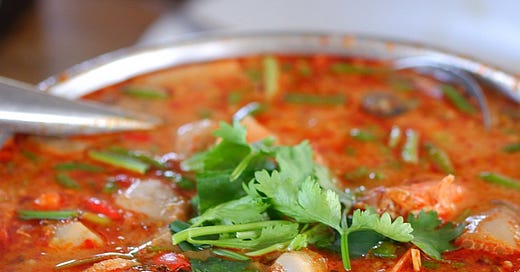Throughout South East Asia a similar blend of ingredients are pounded together and used as the foundation for making curries, sauces (for noodles like Laksa) and more soupy dishes like Tom Yam. In Malaysia these are called Rempah, in Indonesia its Bumbu, in Thailand its Gaeng and in Cambodia its Kreung.
All these spice bases share some ingredients in common:
a savoury base of ingredients like onions, garlic and shallots
Chilies, dried & fresh, local herbs like Lemongrass and Galangal.
Nuts like candlenut
Umami Agents like shrimp paste
Here’s how it breaks down a little further with regional variations createing different colours and flavour profiles:
Malaysia
Rempah Kuning (Yellow Rempah): Uses turmeric, often added to dishes like ikan goreng (fried fish).
Rempah Garam Assam: Contains galangal and tamarind, used in ikan garam assam (sour fish curry) and kuah lada (fish stew).
General Rempah: A basic blend of chilies, garlic, and ginger, suitable for a wide range of dishes.
Indonesia
Bumbu dasar merah (red base): red chilies, garlic, shallots
Bumbu dasar putih (white base): shallots, garlic, candlenut
Bumbu kuning (yellow base): turmeric-based
Thailand
Prik Gaeng Daeng – red curry paste
Prik Gaeng Kiew Wan – green curry paste
Prik Gaeng Kari – yellow curry paste
Cambodia
Yellow kroeung: with turmeric
Green kroeung: with lemongrass, kaffir lime leaves, galangal
Red kroeung: includes dried red chilies
These spice bases are not unlike a sofrito that are sauted in oil and then thickened with Coconut Milk or cooked with a souring agent like tamarind into a thicker gravy.


With trade and the movement of people, early Indian and Arab traders influenced the addition of cumin, coriander, and black pepper. Chinese migration brought fermented bean pastes. The Portuguese brought chillies which made a big impact on South and Southeast Asian cuisine. In Eurasian cuisine more coconut milk is added to moderate spiciness in Fish Moolie or Goan and Malay culinary influences are hybridised in Devil Curry.
Earliest Written Mentions:
“Suma Oriental” (1512–1515) by Tomé Pires, a Portuguese apothecary in Melaka, mentions locals trading and using spices like galangal, turmeric, ginger, lemongrass, and cloves in cooking.
Dutch East India Company logs from the 1600s described Javanese and Malay cooks preparing foods with pounded spices fried in oil.
“Hikayat Abdullah” (1849) — an autobiographical Malay literary work by Munshi Abdullah — refers to cooking methods using pounded spices, though not naming “rempah” explicitly.
In Peranakan oral tradition and early cookbooks (late 1800s–early 1900s), rempah is a central concept in most dishes.
Globalisation
These spice bases have now travelled more widely into Western countries where Tom Yam, Massaman curry, Green curry, Laksa and Malaysian chicken curry to name a few, are now found in many restaurants in big cities in Europe and the USA.




